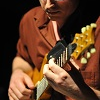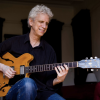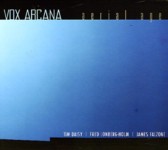Home » Jazz Articles » Interview » Steve Cardenas: From K.C. to N.Y.C.
Steve Cardenas: From K.C. to N.Y.C.

Cardenas' playing mixes the lyrical simplicity of his Midwestern roots with the hustle and bustle of the New York scene, the city he now calls home. Having made a name for himself as the consummate sideman, sharing the stage with Marc Johnson, John Patitucci, Charlie Haden, Norah Jones and Paul Motian, to name a just few, Cardenas has also released three excellent albums under his own name, including 2010's West of Middle (Sunnyside). Though his solo releases tend to be separated by a number of years due to his busy touring and recording schedule, they are definitely worth the wait. Portraying a tonal maturity and love for sonic diversity, Cardenas' albums criss-cross musical genres while remaining firmly set under the umbrella of modern jazz.
Though many of today's up and coming players are drawn to bigger cities like Chicago and New York, with players such as Cardenas carrying the flag, the jazz tradition in Kansas City will remain strong for years to come.
All About Jazz: You're just getting back from Moscow, how was the trip?
Steve Cardenas: It was great, but going over there in the space of less than seventy-two hours was tough, but it was still worth it.
AAJ: Not much time for sightseeing.
SC: No, but actually we did have some time because of the overnight flight. We got in the next day and didn't have to play until that night, so we were able to walk over to Red Square and check out some of what the city had to offer.
AAJ: How do you find the audiences over there and they're reaction to modern jazz?
SC: I didn't notice anything vastly different from the States. They seemed appreciative of the music and seemed to enjoy it. It's hard to compare audiences in different countries like that, especially since things are often different from city to city, let alone country to country.
AAJ: You seem to have a very open approach to the harmony in your writing and performing, which is noticeable on West of Middle. How would you describe your approach to harmony and texture from a compositional standpoint?
SC: It's not necessarily a conscious decision. Composition has always been for me something that I just let happen. I never say "I'm going to write this or in that manner." Compositions just sort of happen. They appear rather suddenly so I'm never thinking that I'm not going to write a two-five, or that I'm going to only use modern voicings or whatever. I love standards, from a compositional and improvisational standpoint. There's a lot of music that I like to play and I don't differentiate things. I know people view things in certain categories, but I just label things as either I like it or I don't.
When I'm writing, I write on guitar. I don't really play piano so much, and things more or less happen in certain ways. It's not premeditated, but when I'm working on a tune I can get this feeling that the tune is going somewhere. Or I might find an idea that I like and can't really seem to place it in anything I'm writing at the moment, so I shelve it for later. Every situation is different. Sometimes I'll write the bulk of something and then finish it a year down the road. I think this is similar to how all writers work, whether they write with music or with words, it seems to be how things work out for composers and writers.
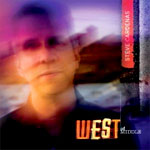 AAJ: You a very lyrical and emotional writer, which gives your music a level of accessibility that one might not expect from modern jazz. Is that how you hear music, or did you consciously set out to write in a style that would appeal to people who like all different styles of music, not just jazz?
AAJ: You a very lyrical and emotional writer, which gives your music a level of accessibility that one might not expect from modern jazz. Is that how you hear music, or did you consciously set out to write in a style that would appeal to people who like all different styles of music, not just jazz? SC: Again, I don't have any conscious thoughts about that stuff. When I'm playing I'm always trying to think about what's best for the song at that particular moment. My favorite players all seemed to approach music that way and I don't think anyone that I know of consciously thinks of doing something more complex or whatever. I don't think that would serve the music in any capacity.
When you think of guys that do play in a complex style, guys like John Coltrane or Michael Brecker, that's how they're hearing the music, and they're very emotional players. Coltrane is one of the most soulful players I've ever heard, so I don't really believe that guys who play more technical have less emotion in their playing. Or the opposite, that guys who play tastefully have to play less notes. We're all playing what we hear and we've all got something to say, and that's that [laughs].
AAJ: You recently spent three months in L.A. doing a teaching residency at Cal Arts. Since you mentioned that audiences, and jazz, differ from city to city, especially between New York and L.A., did some of that West Coast vibe rub off on your playing?
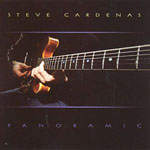 SC: I did the same residency at Cal Arts seven years ago for Larry Koonse, who's the regular guitar teacher there. He's an amazing player, just one of my favorite players and human beings. The scene in L.A. may not be as dense as it is here in New York. There's definitely a lot of creative music happing out there, but maybe not in the concentration as here. Having said that, all the players out there, that I've spent time with and checked out on the scene, are absolutely world class musicians. Whether it's more traditional or more modern, it's all great and very cool to check out. I'm not saying that to be political or anything, that's just what I hear.
SC: I did the same residency at Cal Arts seven years ago for Larry Koonse, who's the regular guitar teacher there. He's an amazing player, just one of my favorite players and human beings. The scene in L.A. may not be as dense as it is here in New York. There's definitely a lot of creative music happing out there, but maybe not in the concentration as here. Having said that, all the players out there, that I've spent time with and checked out on the scene, are absolutely world class musicians. Whether it's more traditional or more modern, it's all great and very cool to check out. I'm not saying that to be political or anything, that's just what I hear. That's actually true of my hometown of Kansas City, which would be considered more of a medium sized city though it has some amazing players. Two of my mentors growing up, Danny Embry and Rob Fleeman, who play with Karrin Allyson are still two of my favorite players to this day. When I was in high school those guys took me under their wings. They would drag me out onto gigs, get me up on stage and scare me to death, all with good intentions of course [laughs].
AAJ: As an improviser you seem to have a wide variety of tones and textures that you use in your playing. You mentioned that don't think of what you're playing in the context of a tune, but are you thinking about how you're playing something?
SC: Those are definitely things that I'll think about. They'll become clearer to me when I get a new tune to a first rehearsal. Then after a gig or two, I'll have a good idea of how I want to approach the overall tone and texture of each section of a tune. For this album, I really felt like on each one of those tunes I found the sound I had in mind for each track.
Some of that was done in the studio, because even though we had rehearsed and gigged most of the tunes, a few of them were new charts when it came time to record them. We changed the form on a couple of things, but it was great, it was all so natural. We might have needed a few extra takes to get the vibe and form of a tune, but it all worked out great.
Getting back to tone, on some of the tracks I wanted a more open sound, like you were saying, but then on others I wanted more bite to my sound, with a bit of distortion to give it a little edge. I just tried to go after what I was hearing in my head for each tune and I think I got that down on the record.
AAJ: You also use a lot of different dynamics in your playing, approaching them as one would scales or arpeggios in the context of a solo. When you were coming up, did you focus on developing this side of your playing in your practicing or did it develop from years on the bandstand, or both?
SC: I would say yes, and I would also say that over time those things became more apparent to me. Actually, when I was teaching, as I felt those things becoming clear to me as a means of shaping the music, I would find that most guitarists would ask me about harmonic ideas, but rarely about touch, rhythms or articulation, those sorts of things. Without those things the harmonic stuff doesn't mean anything. You can learn all you want about those concepts, but when it comes time to play nobody's saying anything, they're just playing.
AAJ: Has this realization led you to teach more by ear or do you still talk things through with your students on a conceptual level?
SC: Every person is different, so I would say all of that happens to different degrees for different people. I don't have a huge agenda when I teach. I don't have a lot of written out exercises because everyone's different. I usually try and get a feel for how they play and where they want to go and work from there. I'll end up writing some things out sometimes, but mostly it's conceptual. Discussing things, doing some playing, talking about time or rhythm, whatever it is the student needs to work on.

AAJ: Getting back to the record, it has a very live vibe to it, very organic sounding. Did you guys use mostly first takes on the album to get that live sound on the tracks?
SC: Yeah it was done live in the studio, and I think that everyone who records live in the studio will do more than one take. Although, you end up using the first take anyway, it just seems to work out that way. Most of the tunes were done with one, two or three takes. Though some of the newer tracks had to be done a few more times because we were still working out the form and getting thing settled in that sense. That was just part of the process of saying, "Here's a new tune how do we make it work right?" Fortunately it worked.
The only tune that had overdubs was "Drifter," which I had in mind from the get go. It's a through-composed piece, with no real improvisation going on. I went in one day after we had finished recording and we picked things that worked and scraped what didn't. At times I was wondering if it was over the top, but considering the vibe of the tune I think I got what I was going for. It's kind of like what the progressive rock bands of the '70s would do. I wanted that tune to evoke that epic, massive sound quality but still feel like it had that small-group element to it at the same time.
Selected Discography
Steve Cardenas, West of Middle (Sunnyside, 2010)
Chris Potter 10, Song for Anyone (Sunnyside, 2007)
Donny McCaslin, Give and Go (Criss Cross, 2006)
Steve Cardenas, Panoramic (Blue Moon, 2004)
Rebecca Martin, People Behave Like Ballads (MAXJAZZ, 2004)
Steve Cardenas, Shebang (Fresh Sound, 2000)
Photo Credit
Todd Chalfant (page 1)
Geert Vandepoele (page 2)
Tags
Steve Cardenas
Interview
Matthew Warnock
United States
Count Basie
Charlie Parker
Lester Young
Karrin Allyson
Marc Johnson
John Patitucci
Charlie Haden
Norah Jones
Paul Motian
John Coltrane
Michael Brecker
Larry Koonse
PREVIOUS / NEXT
Steve Cardenas Concerts
Support All About Jazz
 All About Jazz has been a pillar of jazz since 1995, championing it as an art form and, more importantly, supporting the musicians who make it. Our enduring commitment has made "AAJ" one of the most culturally important websites of its kind, read by hundreds of thousands of fans, musicians and industry figures every month.
All About Jazz has been a pillar of jazz since 1995, championing it as an art form and, more importantly, supporting the musicians who make it. Our enduring commitment has made "AAJ" one of the most culturally important websites of its kind, read by hundreds of thousands of fans, musicians and industry figures every month.

